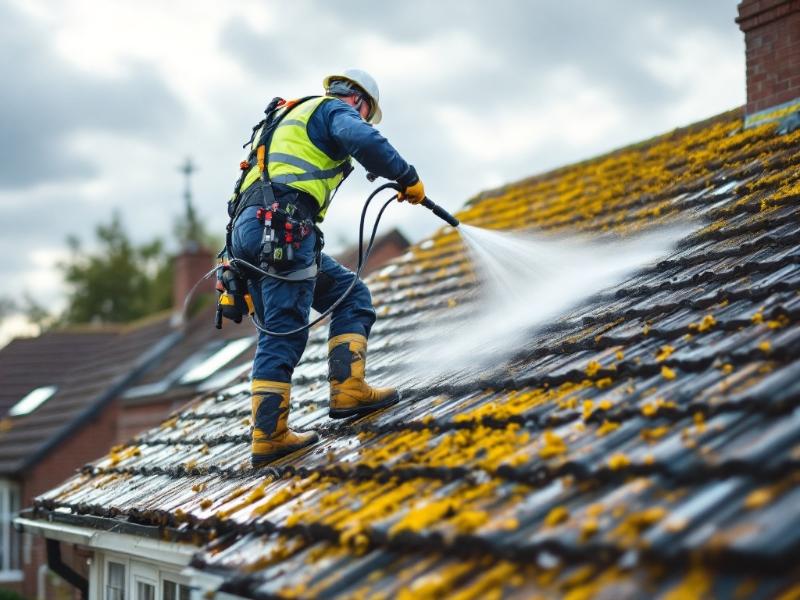The Ultimate Guide to Keeping Your Roof Spotless

By Justin Yates, your friendly neighbourhood roofing expert
Hey there! Let’s talk about something that might not be the most exciting topic, but trust me, your house will thank you for reading this. We’re diving into the world of roof cleaning with tips from my company Roof Wash Team – and I promise to make it as painless as possible!
Why Should You Care About Your Roof?
Think of your roof like a protective helmet for your house. Just like you wouldn’t want a dirty, mossy bicycle helmet, your house deserves better too! Here in the UK, our lovely (often wet) weather means our roofs can get pretty grimy over time.
The Uninvited Guests on Your Roof
You might be surprised to learn what’s actually living up there:
- That green stuff? It’s probably Dicranoweisia cirrata, but let’s just call it roof moss
- Those dark streaks? Say hello to Gloeocapsa magma (blue-green algae to its friends)
- And that yellowish crusty stuff? That’s Xanthoria parietina, or yellow scale lichen
Fun fact: These tiny organisms can cut your roof’s life in half if left unchecked! Not so fun when you think about the repair bills, right?
Let’s Talk Cleaning Methods (The Good, The Bad, and The Wet)
1. The Traditional Approach: Manual Cleaning
What is it? Picture someone carefully scrubbing your roof like a giant’s toothbrush. That’s basically manual cleaning! Below are some tips from my good friends at London Power Washing Team.
Why you might love it:
- Super gentle on your tiles
- Great for spotting any hidden problems
- No chemicals involved (Mother Nature approves!)
Why it might not be your cup of tea:
- Takes ages (we’re talking 6-8 hours for an average roof)
- Results can vary depending on how stubborn the moss is
2. The Power Move: Low-Pressure Washing
What is it? Remember playing with a garden hose as a kid? This is like that, but with science!
The sweet spot:
- Keep it under 2000 PSI for concrete tiles
- Dial it back to 1500 PSI for clay tiles
- Stand about 30cm away at a 30-degree angle (your roof will thank you)
3. The Clever Option: Soft Washing
What is it? Think of it as giving your roof a spa day with specially formulated cleaning solutions.
The science bit:
- Uses eco-friendly cleaning solutions
- Kills 99% of the biological nasties
- Keep your roof cleaner for longer (12-18 months!)
Safety First, People!
Because nobody wants to star in their own “roof cleaning gone wrong” viral video
Essential Safety Gear:
- Non-slip boots (your regular trainers won’t cut it)
- Safety harness (gravity is not your friend up there)
- Weather app (anything over 23mph wind is a big no-no)
The Money Talk 
Let’s break it down in real terms, how much does roof cleaning cost:
Basic Costs:
- Manual cleaning: £200-400 (about the cost of a new smartphone)
- Low-pressure washing: £300-500 (think of it as a weekend away)
- Soft washing: £400-800 (your roof’s luxury spa treatment)
Extra Bits You Might Need:
- Scaffolding: £400-600 (price taken from Scaffold Crew)
- Safety gear: £100-200
- Protective treatments: £200-300
Pro tip: Think of it as an investment – it could boost your property value by up to 5%!
When Should You Get It Done?
The Best Times:
- Late spring to early autumn (when the weather plays nice)
- During dry spells
- When it’s not too hot or cold (8-25°C is perfect)
Warning Signs Your Roof Needs Some TLC:
- More than 25% moss coverage
- Dark streaks appearing
- Constantly blocked gutters
- Tiles looking perpetually damp
Finding Your Roof’s Perfect Match (AKA Choosing a Contractor)
The Must-Haves:





Remember: A good contractor will always offer a proper roof survey and written report before starting work!
The Bottom Line
Your roof works hard to keep you dry – showing it some love once in a while is the least you can do! Regular cleaning might not be the most exciting way to spend your money, but it’s definitely cheaper than replacing your entire roof prematurely.
Want to keep track? Start a roof maintenance diary – future you will be grateful!





